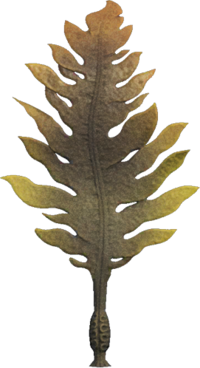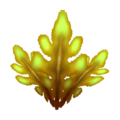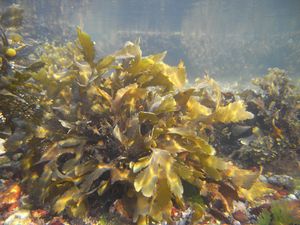Difference between revisions of "Seaweed"
Cephalobot (talk | contribs) m (Text replacement - "\|(.*?)found(.*?)=(.*?)\n" to "") |
Cephalobot (talk | contribs) m (Text replacement - "\|(.*?)timeyear(.*?)=(.*?)\n" to "") |
||
| Line 17: | Line 17: | ||
|scientific name= Undaria pinnatifida | |scientific name= Undaria pinnatifida | ||
|family = Alariaceae | |family = Alariaceae | ||
| − | |||
|timeday= All day | |timeday= All day | ||
|size= 80cm | |size= 80cm | ||
Revision as of 14:54, May 13, 2022
Seaweed (ワカメ, Wakame) is a type of sea creature in the Animal Crossing series, introduced in Animal Crossing: New Leaf. In New Leaf, it is used in the Oyster Salad recipe for the Harvest Festival.
While initially absent from Animal Crossing: New Horizons, Seaweed was added in the 1.3.0 Free Summer Update in July 2020.
Catch details
In New Leaf
| Time of year | Nov - Jul All year (Tortimer Island) |
|---|---|
| Time of day | All day |
| Peak times | Dec - Jun: 9 AM - 4 PM |
| Shadow size | Large |
| Shadow movement | Stationary |
| Sea creature size | 80 cm |
| Selling price | |
| Furniture size |
In New Horizons
| Time of year | North: Oct – Jul South: Apr – Jan |
|---|---|
| Time of day | All day |
| Shadow size | Large |
| Shadow movement | Stationary |
| Spawn requirement | Appears from the start of the game |
| Selling price | |
| Furniture size |
Use in cooking
Seaweed is used as a cooking ingredient in the cooking recipes for the following items:
Recipes in Animal Crossing: New Horizons
| # | Item | Image | Type | Buy price | Available from | Materials |
|---|---|---|---|---|---|---|
| - | [[|Seaweed soup]] | Savory | Not for sale |
Donating to the museum
In New Leaf
Upon the players' donating the Seaweed to the museum, it can be found in the large pool in the first room of the sea exhibit, along with many other species of sea creatures. It is found in the corner near the big rock close to the entrance of the large saltwater exhibit. The exhibit has this to say about the Seaweed:
In New Horizons
When the seaweed is donated to the museum, Blathers will say the following:
The Seaweed is located in the shallow sea fish tank with the walk-through tunnel, to the left of the stairs.
Fishing Tourney
In New Leaf
During a Fishing Tourney, when given a Seaweed, Chip will not score the sea creature but will say the following:
Gallery
Real-world information
Although seaweed resemble plants, they are actually brown algae. The type of seaweed found on beaches and kelp in the ocean are included as brown algae. Worldwide, there are 1500–2000 known species of brown algae. Some species of brown algae, including kelp, can reach 60 meters in length and form underwater forests. Brown algae produce alginic acid, which is extracted for use versatile roles such as waterproofing, fireproofing, gelling agents, thickening agents for ice cream, smoothies, and cosmetics; making impressions for dentistry, prosthetics, and life-casting; and many more. Certain types of brown algae are edible, most notably, nori, which is to wrap rice and meat in sushi. Brown algae reproduce by spores and gametes, and they are most closely related to yellow-green algae.
Names in other languages
| ワカメ wakame |
Wakame | |
| 미역 miyeok |
Wakame | |
| 裙带菜 qúndàicài |
Wakame, lit. "skirtband vegetable" | |
| 裙帶菜 Unknown |
||
| Морские водоросли Morskiye vodorosli |
Seaweed, lit. "sea algae" | |
| Zeewier | Seaweed | |
| Wakame-Alge | Wakame algae | |
| Alga wakame | Wakame algae | |
| Wakame | From Japanese name | |
| Wakamé | From Japanese name | |
| Alga wakame | Wakame algae | |
| Sea creatures | |||||||||||||||||||
|---|---|---|---|---|---|---|---|---|---|---|---|---|---|---|---|---|---|---|---|
| |||||||||||||||||||






